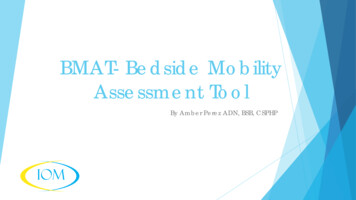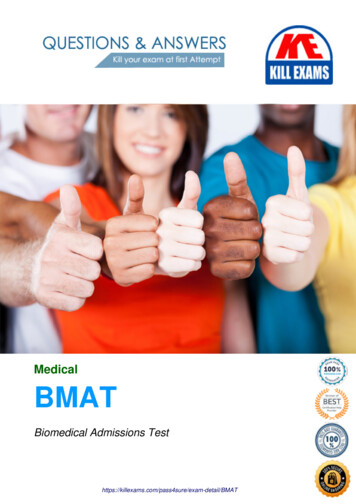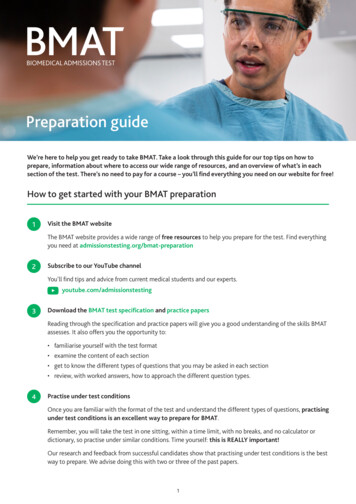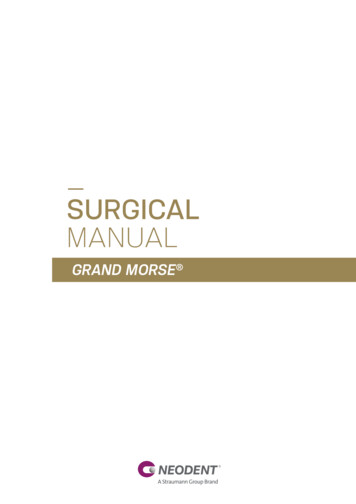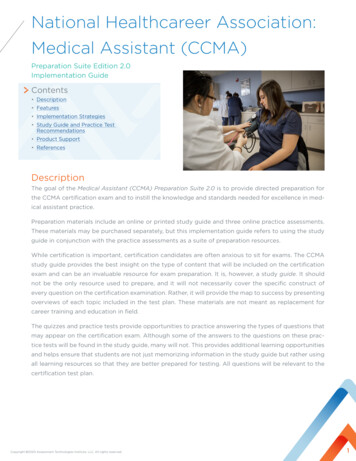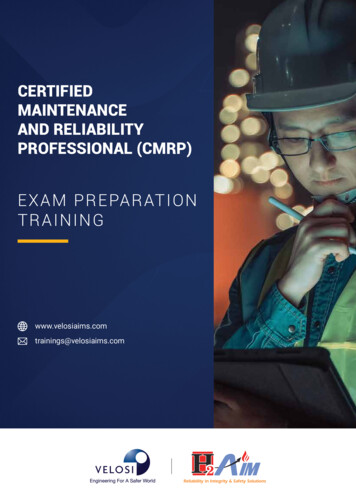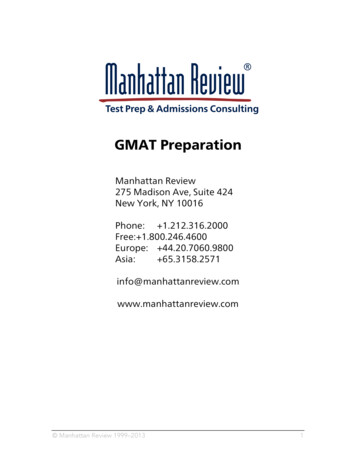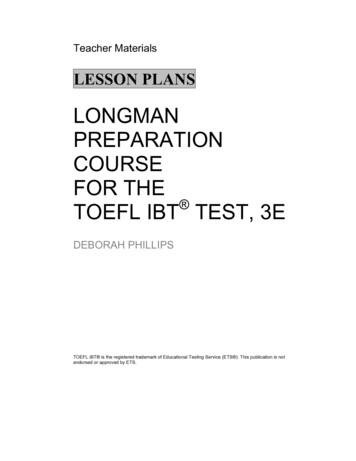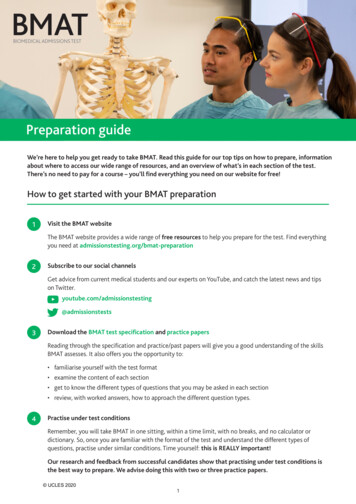
Transcription
Preparation guideWe’re here to help you get ready to take BMAT. Read this guide for our top tips on how to prepare, informationabout where to access our wide range of resources, and an overview of what’s in each section of the test.There’s no need to pay for a course – you’ll find everything you need on our website for free!How to get started with your BMAT preparation1Visit the BMAT websiteThe BMAT website provides a wide range of free resources to help you prepare for the test. Find everythingyou need at admissionstesting.org/bmat-preparation2Subscribe to our social channelsGet advice from current medical students and our experts on YouTube, and catch the latest news and tipson sts3Download the BMAT test specification and practice papersReading through the specification and practice/past papers will give you a good understanding of the skillsBMAT assesses. It also offers you the opportunity to: familiarise yourself with the test format examine the content of each section get to know the different types of questions that you may be asked in each section review, with worked answers, how to approach the different question types.4Practise under test conditionsRemember, you will take BMAT in one sitting, within a time limit, with no breaks, and no calculator ordictionary. So, once you are familiar with the format of the test and understand the different types ofquestions, practise under similar conditions. Time yourself: this is REALLY important!Our research and feedback from successful candidates show that practising under test conditions isthe best way to prepare. We advise doing this with two or three practice papers. UCLES 20201
Tips for each sectionThe following tips outline ways to get ready for the three sections of the test. Everyone has differentstrengths and weaknesses, so only you can determine where you need to focus your preparation and howlong you need to spend on it.Preparing for Section 1Section 1: Thinking Skills32 multiple-choicequestionsThis section tests your ability to solve problems and thinkcritically. No subject knowledge is needed and each questioncontains all the information required to answer it.Please note, from the September 2020 test onwards, the formatof this section is changing slightly. Section 1 no longer containsdata analysis and inference questions, in which a longer text wasfollowed by a set of related questions. For further details, seethe BMAT test specification.6060 minutesFamiliarise yourself with the different types of question and think how best to approach them: Read the Section 1 question guide, which provides an explanation and worked example of the differentquestion types. Download the practice papers with explained answers from the website. Try these questions withoutthe answers, and then look through the explained answers to help you review your own work,particularly where you had trouble with the questions. Look at more practice papers and, when you are ready, try doing some of them under test conditions. Pay attention to which questions you do well on and which you find difficult. Use that to develop yourstrategy for sitting the test. UCLES 20202
Preparing for Section 2Section 2: Scientific Knowledge and ApplicationsThis section tests your ability to solve problems byapplying the knowledge typically covered in non-specialistschool Science and Mathematics subjects by the age of 16(for example, GCSE in the UK and IGCSE internationally).27 multiple-choicequestions3030 minutesWhile the topics and knowledge required are at a level typically covered in school, the questions require you todemonstrate your understanding by applying your knowledge to scientific problems. For this reason, you needto revise your science and mathematics and familiarise yourself with how the questions get you to applythat knowledge.To help you understand the scientific knowledge that BMAT assesses, use: the BMAT test specification, which lists the topics that you may be tested on the BMAT Section 2 guide. This online guide covers the scientific and mathematical knowledge thatSection 2 questions draw on.Much of the content will have been covered in your school-based study of Biology, Chemistry, Physicsand Mathematics. However, you may find some gaps in your knowledge, so use these resources to planyour revision.Familiarise yourself with the way Section 2 tests your application of scientific knowledge: Download the practice papers with explained answers from the website. Try these questions withoutthe answers, and then look through the explained answers to help you review your own work,particularly where you had trouble with the questions. Look at more practice papers and, when you are ready, try doing some of them under test conditions. Mark your answers, and then review where you have gaps in your knowledge. Revise these areasusing the BMAT Section 2 guide or your own books. UCLES 20203
Preparing for Section 3Section 3: Writing TaskThis section assesses your ability to communicate effectivelyin writing, organise your ideas, and present them clearly andconcisely, supporting them with evidence. You are requiredto write a short (one A4 page) essay in 30 minutes.This task requires you to use skills you have already gainedfrom your school work and have used in any report writingyou may have done on your current science courses.1 writing task froma choice of 33030 minutesYou can choose to answer any one of the three questions, which are on a general, scientific or medicaltheme. Select the question that most interests you, and for which you feel you can write the best answer.Do not feel obliged to answer the medical question just because you are applying for Medicine.The questions always have the same format: a proposition (a statement or quote) – e.g. ‘There is moneyto be made from not curing disease.’ – followed by some instructions on how to respond.The instructions will typically require you to explain your understanding of the statement, argue for oragainst the statement, and then explain your view and come to a conclusion.Please note, from 2010 to 2016, Section 3 had a choice of four questions. From 2017 onwards it hasa choice of three.Practise considering both sides of an issue: Practise analysing different opinions and giving arguments for and against different viewpoints. Dothis with articles or news stories you read, and get used to expressing your views about them – maybe bynoting down your thoughts, then thinking about the reasons you have for holding your views. You will use many of the same skills that are assessed in Section 1 questions, such as drawing conclusions,strengthening an argument, and finding flaws in opposing arguments. Sometimes presenting anargument for a view you disagree with can help you find the weaknesses in your own arguments or helpyou to justify your own view. You might also find it helpful to do some wider reading on a variety of subjects, particularly ethics orthe nature of science, and current debates in Medicine. UCLES 20204
Find out how long it will take you to write your answer: Download a sample answer sheet from the website to see the space you will have to write in. Try answering one of the questions using the answer sheet and time how long this takes. This willhelp you establish how much time you will need to write your answer, and how long you can take to planit out.Familiarise yourself with the question format: Download the practice papers with sample responses from the website; these include marks andcomments from examiners. Download more practice papers and the marking criteria, and practise writing some responsesunder timed conditions. This will give you a good idea of how to approach the question. You may findit helpful to ask a teacher or a friend to take a look at what you have written and give you feedback. Youcould also put your response to one side for a few days and then look at it again yourself, alongside themarking criteria.Hear advice from the experts: Watch our Section 3 videos where BMAT markers provide an overview of Section 3 and tips onpreparing for Section 3 and writing your essay. UCLES 2020
On test day You will need to bring a black ink pen, a pencil and an eraser to complete the test. You are NOT allowed to use a calculator, dictionary or correction fluid. You are not allowed rough paper, but you can write on the question papers to mark key information, work outproblems, make notes, draw diagrams and, for Section 3, plan your response. Each section has a time limit. You cannot use any time from one section to work on other sections.Section 1 and Section 2There is an element of time pressure in BMAT; however, you should try to answer all the questions.If you get stuck on a question in Sections 1 and 2, move on to another question and come back to it later.You must have entered all of your answers onto the answer sheet within the time set for each section. Make sureyou allow yourself time to do this as you do not get any extra time at the end.If you are not sure of an answer and are running out of time, choose whichever option you think is most likely.There is no negative marking – marks are not lost for wrong answers, so it’s worth making a guess.Section 3Planning your answer is essential, as you have limited space. This will help you structure your answer and keepyou on topic. Plan your answer on the question paper.Make sure your answer has a clear structure in which you explain the question, present some discussion, andcome to a conclusion.If you include facts, make sure they are correct and support your argument. If you use examples or quotes,keep them short. You have only a small space for your whole argument, and anything written outside the box onthe answer sheet will not be marked.Answer every aspect of the question. If you do not address all parts of the question, your essay will not be able toscore a 3 or higher for content.Towards the end of the test, take a minute to look over your answer and ask yourself: Have you addressed all parts of the question in a relevant way? Have you organised your thoughts clearly? Have you used your general knowledge and opinions appropriately? Have you considered other viewpoints and counter-arguments, and justified your opinions?GOODLUCK! UCLES 20206
Download the BMAT test specification. and practice papers. Reading through the specification and practice/past papers will give you a good understanding of the skills BMAT assesses. It also offers you the opport
